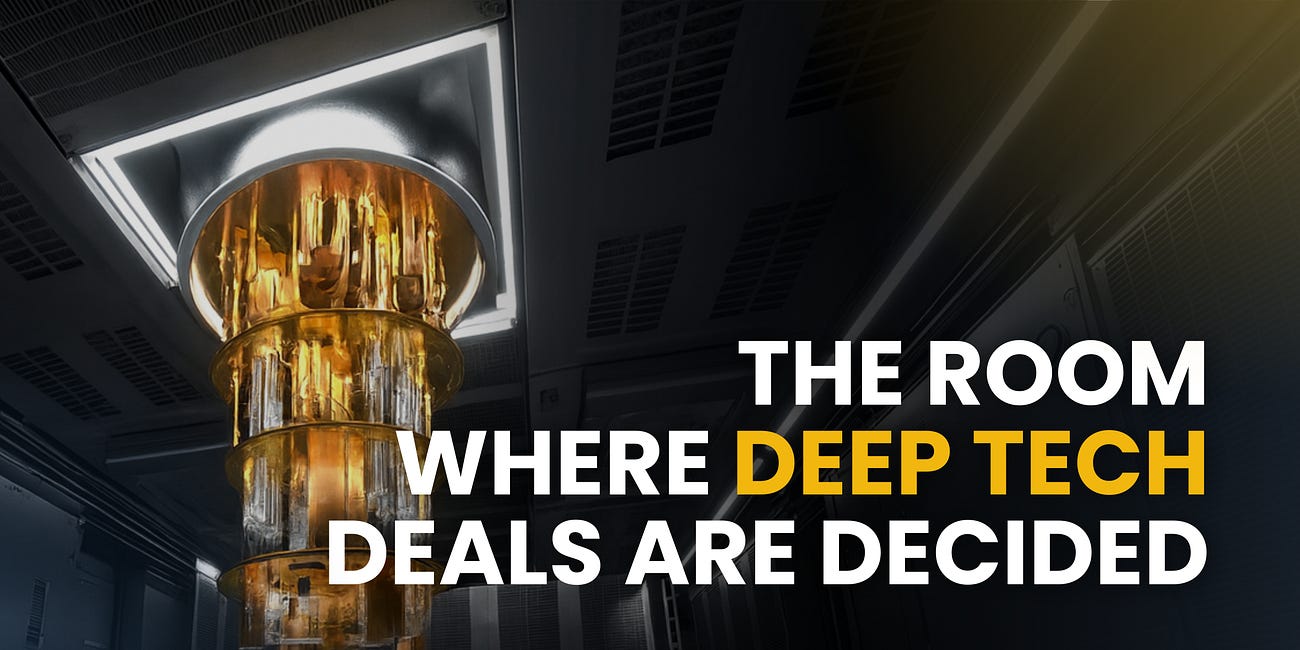💸 $6.1M Seed Space-Station “Warehouse” Bots; $15.5M Seed AI Compute-Thermal Cubelets; $12.7M Pre-Series A Quantum Mineral Sensing; €8M Seed Air-Breathing Propulsion; & more| Capital Movements Vol. 36
The Weekly Observer of Deep Tech Capital Markets: where the money moves, who drives it, and why it matters.
Welcome back to Deep Tech Capital Movements — the weekly observer from The Scenarionist that highlights and analyzes capital dynamics in Deep Tech Capital Markets, from early-stage funding rounds to major fund launches.
Greetings!
This week’s tape says the quiet part out loud: capital is concentrating in platforms that convert AI into industrial throughput—robots that work, chips that ship, networks that don’t melt, and software that closes the loop between compliance, cash, and capacity.
The barbell is back.
On one end, mega-rounds are pricing in category leadership (Figure AI at a $39B mark, Groq at $6.9B post, Strive Health’s $550M equity + debt). On the other, seeds and Series A’s are funding the pipes, picks, and protocols that make those leaders possible (Upscale AI’s nine-figure “seed,” Mueon’s stealth-to-seed for dense compute, Kreios’s VLEO propulsion, Catena’s universal telematics API).
The middle is thinner, but not empty: defense-grade manufacturing (Divergent, $290M Series E), physics-informed CAE (Luminary Cloud, $72M B), and brand protection at software margins (MarqVision, $48M B) show disciplined growth getting paid.
Three patterns stand out.
First, embodied AI is shifting from demo to deployment. Dyna Robotics raised $120M to push a foundation model toward physical AGI, while Raion Robotics’ $16.5M aims at mass production after endurance proofs.
Figure’s valuation reset—whether you love it or worry about it—signals that public and private capital are betting humanoids will exit the “cool demo tax” and enter real unit economics in logistics, inspection, and light assembly. Icarus’s $6.1M seed for ISS “warehouse work” looks small against those figures, but it’s an important tell: constrained environments, high value-per-task, and teleop-to-autonomy ramps are where embodied AI’s learning curves compound fastest.
Conceivable’s $50M to robotize IVF labs fits the same arc—tight, regulated workflows where repeatability beats raw dexterity.
The meta-thesis: software-defined manipulation advances first in narrow, high-stakes niches, then generalizes. Expect more “boring” labs and depots soaking up capital while humanoids chase broader TAM.
Second, the AI infrastructure stack is getting re-architected across compute, interconnect, and data operations—by companies that look more like systems vendors than SaaS. Groq’s $750M signals that ultra-low-latency inference is an investable wedge, not a curiosity, and Mueon’s “Cubelets” seed tells you density, thermals, and power delivery are now board-level constraints, not back-of-house engineering.
Upscale AI’s >$100M seed to build an open, AI-native network fabric is a striking datapoint: networking is becoming an AI product surface, with XPU-centric designs and SONiC/SAI standardization as distribution.
On the “soft” side of the hard stack, Invisible’s $100M at $2B+ and Tabs’s $55M show that human-in-the-loop orchestration and AI-native revenue ops are no longer cost centers—they’re control planes for model reliability and cash conversion. Vega’s $65M to replace centralized SIEM with a federated “security analytics mesh” tracks the same direction: analyze in place, move less data, shorten the investigative loop. Irregular’s $80M for AI safety evaluations underscores an uncomfortable reality: model risk now rises with scale; testing must scale faster.
Third, atoms are investable again—but with sensors, biology, and policy leverage.
Quantum gravimetry (Atomionics, $12.7M) and phytomining (Genomines, $45M A) blend precision measurement and engineered biology to derisk mineral discovery without moving as much dirt. BIOWEG’s €16M and Terra Oleo’s $3.1M point to bio-based materials and fermentation as near-term substitutes where regulation and brand pull are aligned.
Equilibrium’s $3M to operationalize nature-based carbon removal across smallholders is a reminder that durable decarbonization is part MRV software, part project finance, and part community operations. On energy flexibility, Suena’s €8M for AI storage trading targets the cash register of the transition: arbitrage + availability.
The fund side is quietly decisive here: EIF’s €260M anchor into Jolt Capital V (deeptech growth), Suma Capital’s €210M for industrial decarb, and VoLo Earth’s $135M all tilt Europe toward scale-up capital rather than science projects. Oneworld’s SAF-focused vehicle with BEV is the more interesting signal: airlines are moving from offtake press releases to cap table relevance—hard tech needs that.
Defense and space are no longer separate beats—they’re demand signals for advanced manufacturing. Divergent’s $290Mat a $2.3B valuation, with named aerospace primes, is the clearest case of software-defined factories graduating from automotive cool factor to defense-grade volume.
Microfactory’s $1.5M pre-seed sits at the other end, but it rhymes: small-footprint automation for short-run, high-mix production. Kreios Space’s €8M for air-breathing electric propulsion in VLEO is classic European deeptech—physics-forward, capex-light milestone, potentially capex-heavy scale. If the in-orbit demo works, revisit the TAM assumptions for persistent sensing and comms at very low altitudes.
Healthcare showed two distinct modes. Strive Health’s $550M (equity + debt) is value-based care’s scale play: AI-enabled orchestration applied to high-cost chronic populations where payer-provider alignment funds growth. Odyssey’s $213M for autoimmune precision medicines is a classic “advance the pipeline through milestones” round.
On the tooling side, Trially’s $4.7M for AI recruitment agents is a wedge into the clinical bottleneck, while RegScale’s $30M+ B to encode compliance as code (with Microsoft’s M12 and others) recognizes that regulated workflows—health, energy, defense—are where AI copilots meet audit trails.
If there’s a through-line in this week’s cap tables, it’s the rise of strategic capital and distribution-aware rounds. Intel Capital backing Mueon, Wesco anchoring Kojo’s $10M extension to co-build AI procurement tools, Salesforce Ventures appearing in both Dyna and MarqVision, NVIDIA’s NVentures in Luminary—these are not passive checks.
They’re forward contracts on supply chains, channels, and standards. In a high cost-of-capital regime, that matters: the cheapest growth is the growth you can route through someone else’s installed base.
Geographically, the U.S. still dominates absolute dollars, but Europe is showing teeth in propulsion, decarb funds, and bio-based materials; Israel and the U.S. continue to co-produce cybersecurity primitives (Vega, Irregular); Singapore punches above weight in quantum sensing and alt fats. Asia’s robotics signal (Raion) and India’s circularity (PeakAmp) round out a week that looked genuinely global.
Where does this go next? Expect continued bimodality. Mega-checks will chase perceived platform winners in humanoids, inference, and value-based care, while disciplined seeds will finance enabling layers—network fabrics, procurement rails, safety evals, industrial APIs.
The middle will clear for companies with proof of revenue against non-speculative demand: defense, energy markets, regulated workflows.
Watch for two catalysts:
(1) tangible unit economics from humanoid pilots (MTBF, service contracts, task libraries), and (2) network-level benchmarks from AI-native interconnects (latency under mixed loads, failure isolation at scale). If those show up, multiples will follow.
For operators, the takeaway is simple: earn distribution, not headlines. For investors, favor businesses that collapse a critical path—compute density, model reliability, logistics manipulation, compliance closure—into a product that compounds with each deployment.
The capital is telling you what it wants: less sizzle, more throughput.
See you next week, Enjoy the read!
For more, see Membership | Exit | Deep Tech Briefing | Deep Tech Catalyst | Insights | Rumors | VC Guides
Startup Deal Activities to Watch:
🔸 Mueon Emerges from Stealth with $15.5M Seed to Redefine Data Centers for the AI Era
Mueon launched from stealth with a $15.5 million seed round led by Intel Capital, joined by Geodesic Alliance Fund and Oregon Venture Fund. The company introduced “Cubelets,” stackable modular building blocks that tightly integrate compute, memory, power delivery, and thermal management to boost density and efficiency in AI and hyperscale workloads.
Deal: Seed Round
Region: United States
Industry: Data Center Infrastructure, Semiconductors
Sector: AI & Cloud Infrastructure
Tech: Modular “Cubelets,” Integrated Compute–Memory–Power–Thermals, High-density/energy-efficient systems
🔸 Icarus Raises $6.1M Seed to Automate Space Station “Warehouse Work” with Embodied-AI Robots
Icarus closed a $6.1 million seed round led by Soma Capital and Xtal to develop dexterous robots that can unpack, stow, and handle ISS cargo tasks. The startup plans parabolic







